JARS v59n4 - A Trip to Mount Fan Si Pan, Vietnam
A Trip to Mount Fan Si Pan, Vietnam
Garratt Richardson
Seattle, Washington
My arrival in Vietnam in February 2004 was very different from the one thirty-five years before in December 1969. As a general medical officer in the US Army, I landed in South Vietnam at Bien Hoa airport outside Saigon. Twelve months were spent on duty near the de-militarized zone separating the divided country. That spring, several physicians rode in an open jeep from Hue, the old Imperial capital, to Danang, along a very well maintained blacktop road. We were on our way to a medical meeting, partly as an in-country "R&R," and also to learn about maladies peculiar to Southeast Asia such as rashes, malaria and snake bites. The scenery was spectacular: huge white cumulus clouds rising behind a ridge of low mountains, brilliant green rice paddies with farmers and their water buffaloes in the foreground. The possibility of rhododendrons on those mountains never entered my mind.
Wintertime in Seattle is comparatively mild but can be gray, cool and rainy. A trip to Southeast Asia promised to be dry, hot and sunny. I scheduled a trip to Thailand, Laos and Vietnam. Searching for local rhododendrons would be an interesting focus. Keith Rushforth has made four trips to Vietnam centered primarily in the area around Mount Fan Si Pan. In Vietnamese, this mountain is spelled Phang Xi Pang. It is the highest mountain in Vietnam at 3,143 meters (10,312 ft) and is located in the Hoang Lien Mountains, which are an extension of the Ailao Shan in China, the southeastern extension of the Himalayan Mountains. This range is found in the northwest part of the country. Mount Fan Si Pan has been included in the Hoang Lien Son–Sa Pa Nature Reserve. The Nature Reserve contains 11,071 hectares (over 27,000 acres) with considerable variation in altitude, topography, hydrology and microclimate. There are 2,024 known species of vascular plants, 340 species of birds and half of Vietnam's known amphibians (1). Unfortunately, exploitation of the natural resources along with the clearance of land for cultivation and livestock is destroying the natural vegetation. Forest management schemes have been devised, but a lack of funding has limited the enforcement of the Nature Reserve regulations (ibid.)
Keith has made some remarkable discoveries here, not only of rhododendrons but also of other plants: new species, subspecies and range extensions (2-4). A vireya rhododendron that he discovered there has been named Rhododendron rushforthii . My acquaintance with Keith started when he led a trip to Bhutan in 1988, which was my first plant-hunting trip. He provided me with extremely useful information regarding local contacts, logistics of trekking and accommodation and where and what I might find on the mountain range. Tom Hudson, who had accompanied Keith on one of the trips, provided more details as well. Keith gave me the name of an acquaintance, Linh Thuy Do, in Hanoi who arranged for a Vietnam visa that was obtained through faxes to my travel agent in Bangkok where I was staying. The arrival in the country via Vietnam Airlines went very smoothly. The Noi Bai airport serving Hanoi is brand new and large. The second floor is expansive and empty. Only a cafeteria and small gift shop are found on the main floor near the ticket counters. American-owned airlines have just begun flights to Vietnam. A refreshing aspect of this airport and this part of the country is a complete lack of American enterprise. Despite this absence, monetary transactions are in Vietnamese dong or American dollars.
Linh arranged for the overnight train from Hanoi to Lao Cay, a town located in the northwest of the country, on the border with China and situated on the Song Hong or Red River. Several mini-buses wait at the station for the arrival of this train at about 8 a.m. It is an hour-long bus ride on a paved road to SaPa, a town of 36,000 people. It sits at 1,654 meters (5,400 ft) and was built by the French in the 1920s as a hill station to escape the lowland tropical heat. After the defeat of the French in 1954, the town fell into disrepair but has recently become a bustling center of development. Hotels are springing up like mushrooms for the anticipated increase in tourism with both national and international visitors. In February with the end of winter characterized by cold, fog and drizzle, there were very few tourists. There are several interesting tourist activities located in this area. The largest ethnic groups or "Montagnards" are the Black H'mong and the Red Dzao. The ethnic Vietnamese are in the minority here. Many people come here to trek between local villages. Saturday is the busiest market day when the Montagnards come to town to buy, sell and socialize. Young men and women wear their finest native dress and stand in groups to see and be seen. Others come to climb Mount Fan Si Pan.
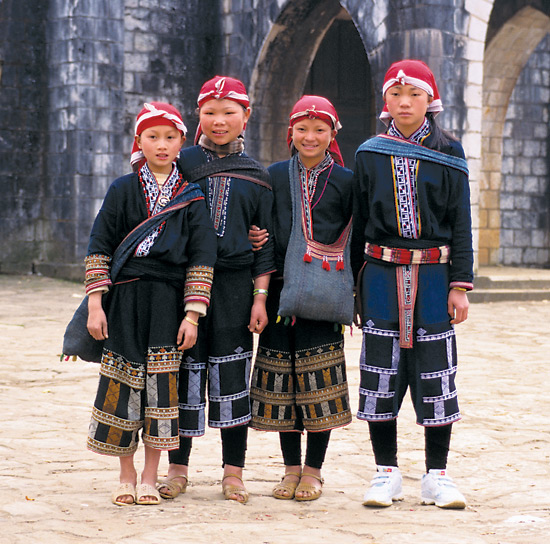
|
|
Dao girls.
Photo by Garratt Richardson |
My hotel was only a few years old; a fireplace helped warm the foyer, but the stairwells were open to the dampness. However, each room had its individual heater to make things very comfortable. I met with the tourist agent with whom I outlined my itinerary. The following morning Thang, the guide in his mid 20s, and Dao, the porter in his mid teens, were in the lobby promptly at 10. I had brought no trekking gear on this trip. Because of the dampness, cold and possible rain, I purchased extra shoes and a heavy jacket. Thang had his own gear to carry and Dao had his gear as well as all the trip's provisions. It was clear that I was going to have to carry all my own stuff. Thang assured me that I wouldn't need so much gear so I dispensed with the newly purchased things and lightened my load by 10 lbs. Fortunately sleeping bags and shelter were going to be provided at the permanent campsite.
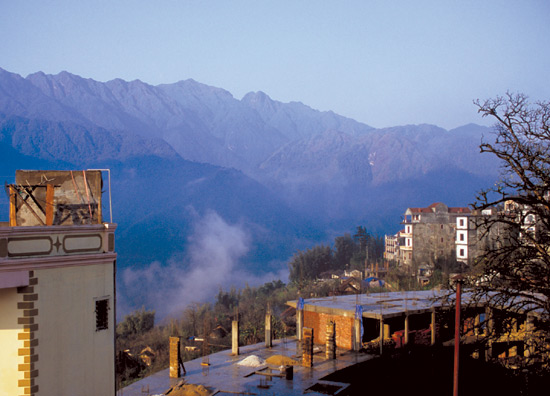
|
|
Mount Fan Si Pan, the highest peak in the center of the
Hoang Lien Mountain Range, seen from SaPa. Photo by Garratt Richardson |
A jeep took us to Tram Ton Pass, 15 km northwest of SaPa. This pass is on the Hoang Lien Mountain range, at 2,015 meters (6,600 ft), and divides two weather systems. The eastern side or SaPa side is cold and foggy; the western side towards Lai Chau is warm and sunny. Strong winds and fog occur as a result of the interaction between these two climates. The wind caused quite a chill factor at a temperature of 50° F (10° C). The trail is narrow and feeble suggesting it is not well traveled. The lack of evidence of pack animals might account for the welcome absence of leeches; higher parts of the path are clearly inaccessible to horses. Over the next few hours, we reached an elevation of 8,000 feet (2,440 m). At lunch by a picturesque stream, 2-foot-high mature specimens of a member of the Pseudovireya Alliance, possibly Rhododendron emarginatum , grew on mossy logs.
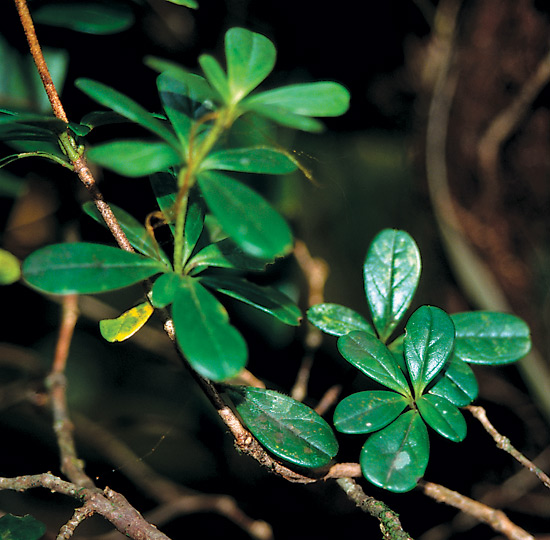
|
|
R. emarginatum
.
Photo by Garratt Richardson |
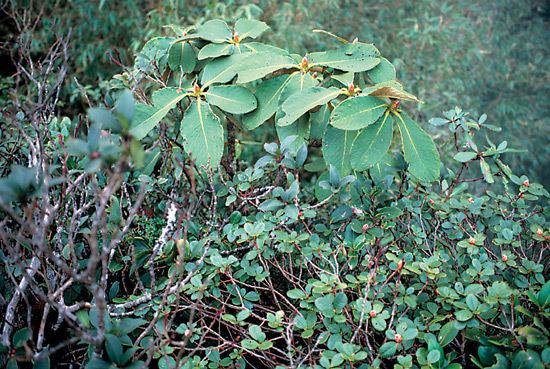
|
|
R. sinofalconeri
and
R. valentinianum
var.
oblongilobatum
.
Photo by Garratt Richardson |

|
|
Primula
, unidentified.
Photo by Garratt Richardson |
Seedlings of a Maddenia whose parents must have been upstream were also there. After lunch, we entered a more pronounced broadleaf evergreen forest. Rhododendron tanastylum , in full bloom with cherry red flowers, was scattered throughout the forest. Although I had never seen this plant before, identification was easy: 12-inch square green metal labels had been nailed to a number of trees including oaks and other non-rhododendrons. The names were printed in Latin and included R. tanastylum , klossii (now included in R. moulmainense ), cavalieri (now included in R. stamineum ), and moulmainense . Only mature specimens were seen and were about 30 feet high making it impossible to examine them more closely. None of the others was in bloom and the forest floor was remarkably clear of young plants. A seedling of R. arboreum affinity was identified but no parent plant was seen. Keith Rushforth thinks that this plant is a new taxon. We passed a field of cardamom. There is concern this crop is a contributor to the destruction of the Reserve's natural vegetation. The only other sign of civilization was a burned off area that had been turned into a pasture for a few water buffalo and horses. Here is a further sign of loss of forest cover. The animals had made dozens of trails through this high grass area and would make it impossible for the novice trekker to discern the main path over the crest. We descended 600 feet into a dark valley where the permanent campsite is located. A platform, which can sleep eight or nine people, has been erected. The roof has been further covered with a tarp for rain proofing. A separate little building is used for cooking, eating and sleeping. Three young men live there to cook the food brought by the hikers and maintain the place. A hiker from London had joined us for a superb five-course meal prepared the first night. During the night, fascinating loud bursts of wind would pass over the treetops, lasting five to ten minutes, and fortunately did not affect the cabin. The next morning we dropped down another 400 feet before a virtual non-stop ascent to the top of Mount Fan Si Pan. R. maddenii , sinofalconeri , lepidotum , valentinianum var. oblongilobatum and facetum were identified. The last species has a notably indumented midrib. The trail was rugged with roots and rocks including a 20-foot rock face that required pulling oneself over it with a rope.
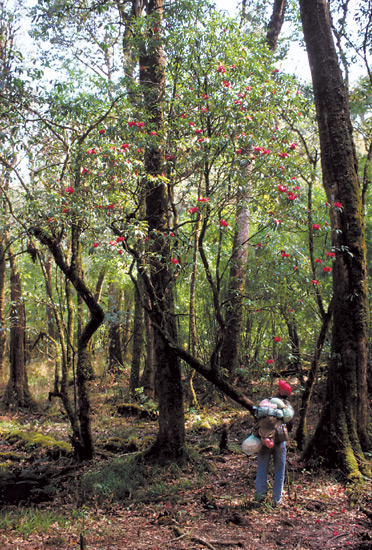
|
|
R. tanastylum
, tree.
Photo by Garratt Richardson |
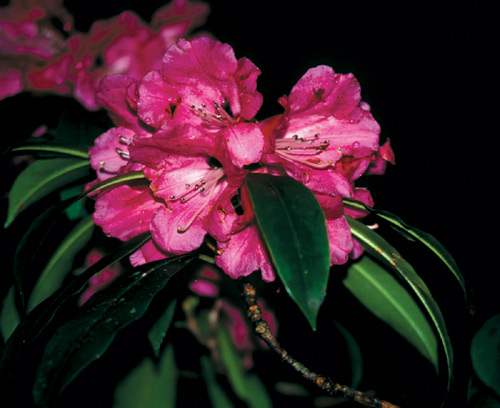
|
|
R. tanastylum
, flowers.
Photo by Garratt Richardson |
The peak of the mountain is at 3,143 meters (10,350 ft). Fog and wind made it seem a lot colder than the recorded temperature of 45° F. Snow has been seen occasionally on the mountain. No different rhododendron species were seen at the summit. A Vietnamese flag and a glass-enclosed case of a bust of Ho Chi Minh along with a commemorative plaque are situated at the rocky but heavily vegetated peak.
Only Dao, my porter, was with me now. He recommended we take an easier route back, to which I agreed. Climbing down that rock face was not a pleasant prospect. The fog was still dense and plants were difficult to identify. The trail was definitely better although there were some narrow ridges; swaths of red petals from overhanging camellias occasionally decorated the path. Unfortunately, it took two additional hours to return to the cabins and we returned just at dark. Intermittent rain and hail occurred during the second night. They had stopped by the time we had finished our chocolate banana crepes - a remnant from French colonial days. We left for SaPa by a different route to the northeast via Sin Chay. It was more difficult with very narrow ridges and slippery, muddy chutes. More flowering R. tanastylum was seen; R. excellens and maddenii ssp. crassum were identified but not blooming. Sin Chay is a H'mong hamlet and women in their beautiful traditional clothes were working away in the fields. Thang made contact for a vehicle and we drove back to SaPa.
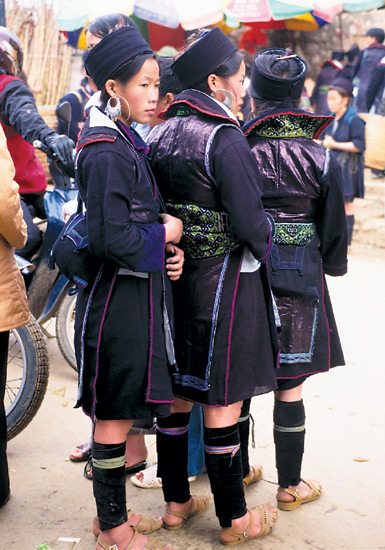
|
|
Black H'mong girls.
Photo by Garratt Richardson |
The trip was highly enjoyable for the botanical, cultural and trekking aspects. I was lucky with the weather but could have been much luckier in rhododendron identification. Keith Rushforth has recorded over thirty species of rhododendrons on this mountain range. I only identified a dozen, with the help of some labels. The identification of the many new taxa is still ongoing. The hardiness of these plants for temperate climates such as Britain and the mid-North American west coast is also still being tested. In 2002 Ted Millais, located in Surrey, southwest of London, reported with great enthusiasm the success in growing several of the species collected by Keith (5).
Trying to find the rest of the elusive species is a good incentive to return.
References
1. Hoang Lien Son-Sa Pa Nature Reserve. Sourcebook of Existing and
Proposed Protected Areas in Vietnam Updated 19/02/O1 (online)
2. Rushforth, Keith. 1993. Rhododendron Hunting in Vietnam.
RHS
Rhododendrons with Camellia: and Magnolias
45: 38-46.
3. Rushforth, Keith. 1998. Further Rhododendron Hunting in Vietnam.
RHS Rhododendrons with Camellias and Magnolias
49: 34-38.
4. Rushforth, Keith. Further Rhododendron Hunting in Vietnam, Part
2. 1999.
RHS Rhododendrons with Camellias and Magnolias
50:
13-17.
5. Millais, Ted. 2002. Changes in Climate and Their Effects on
Rhododendrons.
RHS Rhododendrons with Camellias and Magnolias
53:14—18.
Garratt Richardson is a member of the Seattle Chapter.
